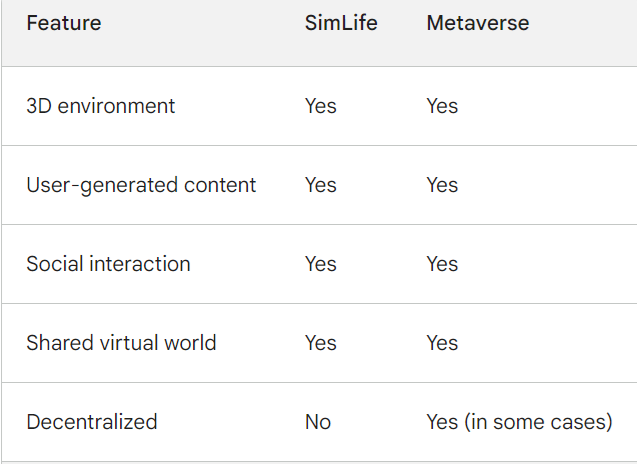Sim Life >Metaverse: How DSID fits in the game
Abstract
This paper explores the evolutionary connection between three groundbreaking concepts: SimLife, the Metaverse, and how DISD (digitalsocial.id) fits in the game.

SimLife, a pioneering computer simulation game released in 1992, introduced the notion of inhabiting and interacting within a virtual ecosystem. Over time, the concept of a shared, immersive digital realm evolved into the metaverse, a convergence of physical and virtual worlds where users can interact, collaborate, and experience new forms of reality. DSID, self-sovereign digital identity platform, emerged as a potential solution to the challenges of identity management in the metaverse, enabling individuals to control their personal data and establish ownership over their digital identities.
The intersection of SimLife, the Metaverse, and DSID represents a significant paradigm shift in how we interact with technology and each other. The future of these technologies holds immense potential for transforming our lives, from enhanced communication and collaboration to new forms of entertainment and education. This paper serves as a springboard for further exploration and discussion of these transformative technologies and their potential impact on society.

In a sense, SimLife can be considered a proto-metaverse, as it introduced many of the core concepts that have become central to the metaverse, such as
- Immersive 3D environments: SimLife provided users with a fully customizable 3D environment in which they could interact with simulated life forms. This immersive experience laid the groundwork for the immersive worlds that we now see in the metaverse.
- User-generated content: SimLife allowed users to create and modify their own content within the game, which gave them a sense of ownership and control over their virtual world. This user-generated content model is now a common feature of the metaverse.
- Social interaction: SimLife enabled users to interact with each other in their virtual world, creating a sense of community and shared experience. This social interaction is a key aspect of the metaverse, as it allows users to connect with others from around the world.
While SimLife was a relatively simple game compared to modern metaverse platforms, it’s important to recognize its significance as a pioneer of the concept. It demonstrated the potential of virtual worlds to provide immersive experiences, user-generated content, and social interaction, all of which are essential elements of the metaverse.
As the metaverse continues to develop, it is likely to incorporate even more innovative features that were not possible in SimLife, such as:
- Immersive augmented reality and virtual reality experiences
- Real-time collaboration and productivity tools
- Fully integrated economies with cryptocurrencies and non-fungible tokens (NFTs)
- Seamless integration with the physical world through wearable technology
How DSID can Enhance the SimLife Experience in the Metaverse
DSID has the potential to revolutionize the way we interact with virtual worlds, including the game SimLife. Here are some specific ways in which DSID can enhance the SimLife experience:
- Secure and Private Identity Management: DSID can enable users to create and manage their own digital identities within the game, ensuring that their personal data is secure and private. This would prevent third-party platforms from collecting and monetizing user data without their consent.
- Decentralized Ownership of Virtual Assets: DSID can be used to represent ownership of virtual assets in SimLife, such as creatures, items, and land. This would create a more transparent and secure system for trading virtual assets, and it would also give players more control over their own virtual possessions.
- Seamless Cross-Platform Interoperability: DSID can be used to connect different virtual worlds, allowing players to seamlessly transfer their identities and assets between platforms. This would create a more unified and interconnected metaverse experience.
Here are some specific examples of how DSID could be used in SimLife:
- Create a DSID-based marketplace for virtual creatures and items.
- Implement a DSID-based authentication system for accessing private areas within the game.
- Develop a DSID-based reputation system that tracks players’ actions and achievements.
- Integrate DSID with SimLife’s AI system to create more realistic and personalized interactions.
The integration of DSID into SimLife would not only enhance the game’s functionality but also make it a more secure and user-centric experience. By empowering players to control their own identities and assets, DSID would lay the groundwork for a more decentralized and interoperable metaverse experience.
SimLife, the metaverse, and DSID represent three transformative technologies that are poised to reshape the way we interact with digital worlds. By combining the immersive experiences of SimLife with the decentralized identity management and interoperability of DSID, the metaverse can become a truly transformative space for innovation, collaboration, and personal expression.
Metaverse is likely to have a profound impact on the way we live, work, and interact with each other. SimLife may have been just a simple game, but it played a crucial role in paving the way for this exciting new frontier. As the metaverse continues to evolve, DSID will play an increasingly important role in ensuring user privacy, ownership rights, and interoperability. The integration of DSID into SimLife and other metaverse platforms will be essential for creating a more secure, seamless, and user-centric experience for all participants.
Sim Life >Metaverse: How DSID fits in the game was originally published in Coinmonks on Medium, where people are continuing the conversation by highlighting and responding to this story.
